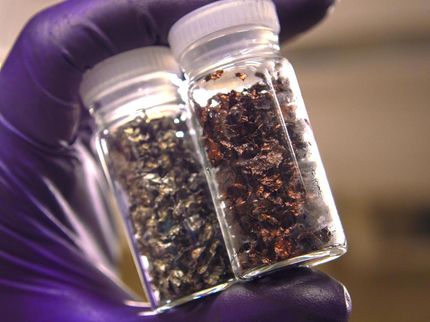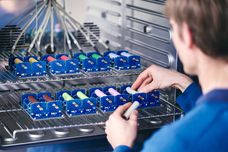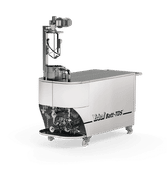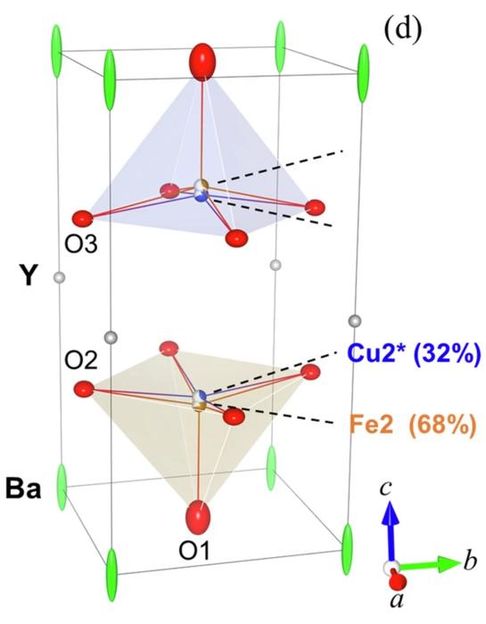Captured lithium
Neutrons show effective lithium and electrolyte distribution in lithium-ion cells
Advertisement
In our smartphones, our computers and in our electric cars: We use rechargeable lithium-ion batteries everywhere. But their capacity drops after a while. Now a German-American research team has investigated the structure and functionality of these batteries using neutron diffraction: They discovered that the electrolyte fluid's decomposition products capture mobile lithium in the battery and that the distribution of lithium within the cell is surprisingly uneven.
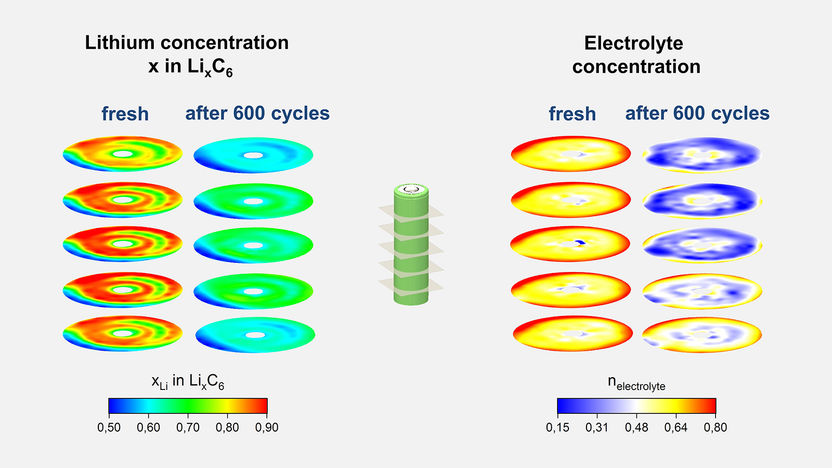
Color-coded concentration of lithium (left) and electrolyte (right) in a fresh and an aged (600 charge or discharge cycles) lithium-ion cell.
A. Senyshyn / TUM
The outstanding characteristics of the lithium-ion battery have changed our everyday lives as only very few other inventions have. However, over time various effects occur which gradually reduce the great storage capability of these batteries.
At the Technical University of Munich’s Research Neutron Source Heinz Maier-Leibnitz (FRM II) Dr. Anatoliy Senyshyn, instrument scientist at the high-resolution powder diffractometer SPODI, used neutron scattering to investigate the cause of these effects in cylindrical lithium-ion batteries.
Together with other scientists he is searching for answers to fundamental questions on the structure and behavior of rechargeable lithium-ion batteries: Why does the available capacity drop over time? How is the lithium distributed in the battery?
Why use neutrons to investigate a rechargeable battery?
Observing a lithium-ion cell's interior during charging and discharging, for example the decomposition of the electrolyte or the distribution of the lithium, is very difficult from outside of the cell due to the high reactivity of the cell components with oxygen and air humidity.
Neutrons are particularly sensitive with regard to lighter elements such as hydrogen and lithium. Therefore they can render the lithium inside a cell visible, making investigations possible under actual operational conditions.
Another advantage of working with neutrons is that they can be used in non-destructive testing. Thus for example the researchers can observe internal battery processes from outside without intervening in the delicate system.
Why does battery capacity sink?
Lithium-ion cells produce electricity as lithium atoms release electrons which then flow through a connected device. At the same time, inside the cell a lithium ion moves from one electrode to the other; this means there are always only as many electrons available as there are lithium ions. When the rechargeable battery loses capacity, it can also be said that the lithium "gets lost". But where does it go?
The neutron scattering experiments at the instruments STRESS-SPEC and SPODI indicated a linear relationship between the loss of mobile lithium ions and the decomposition of the electrolyte, which occurs for example as unwanted side reaction during charging.
The products resulting from the electrolyte decomposition trap lithium atoms which are then no longer available as mobile lithium to be exchanged between the two electrodes. As a result, the battery loses capacity: It ages.
How is the lithium distributed?
Until now theoretical models, calculations and measurements usually assume an even distribution of lithium in these batteries. However, the investigations indicate that the lithium is very unevenly distributed from the very beginning; and the inhomogeneity rises over time.
Modelling of lithium-ion cells can be significantly improved when developers take this uneven lithium distribution into account. In addition, statements can be made about the storage ability of the lithium-ion cell based on the lithium distribution. These results are an important basis for making more efficient rechargeable batteries with longer service lives and higher performance in the future.
Original publication
Dominik Petz, Martin J. Mühlbauer, Alexander Schökel, Klaus Achterhold, Franz Pfeiffer, Thilo Pirling, Michael Hofmann, and Anatoliy Senyshyn; "Heterogeneity of graphite lithiation in state-of-the-art cylinder-type Li-ion cells"; Batteries and Supercaps; 28. Okt. 2020.
M.J. Mühlbauer, D. Petz, V. Baran, O. Dolotko, M. Hofmann, R. Kostecki, A. Senyshyn; "Inhomogeneous distribution of lithium and electrolyte in aged Li-ion cylindrical cells"; Journal of Power Sources; 475 (2020) 228690
Other news from the department science
These products might interest you
Most read news
More news from our other portals
See the theme worlds for related content
Topic World Battery Technology
The topic world Battery Technology combines relevant knowledge in a unique way. Here you will find everything about suppliers and their products, webinars, white papers, catalogs and brochures.

Topic World Battery Technology
The topic world Battery Technology combines relevant knowledge in a unique way. Here you will find everything about suppliers and their products, webinars, white papers, catalogs and brochures.



